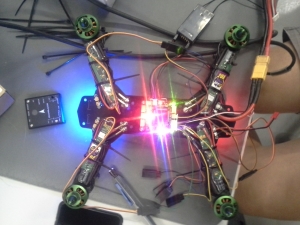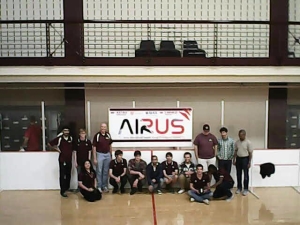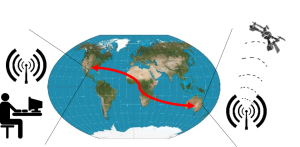On Dec. 5 2015, the Aerial International Robotic Racing of Unmanned Systems (AIRUS) broke a record for longest distance between a remotely operated civilian Unmanned Aerial System (UAS) which is sometimes referred to as a drone, and its pilot. Students from Texas A&M University landed an unmanned aerial system on the other side of the world, while their counterparts at the University of Sydney in Australia did the same.
The idea was proposed several years ago by Dr. Gregory Chamitoff, and Dr. John Valasek, professors at Texas A&M, and Dr. KC Wong, professor at the University of Sydney. The original concept was to have a fully international UAS race in which several teams from different parts of the world could race against each other by piloting the UASs remotely. This race event would go on as a recurring series with obstacle courses at various parts of the world where the teams could try their luck, without actually being physically present.
The Texas A&M AeroSpace Technology Research and Operations Center (ASTRO) as well as the Center for Autonomous Vehicles and Sensor Systems (CANVASS) helped support this project. The School of Aeronautical Mechanical and Mechatronic Engineering and the AeroSpace Technology and Research Australia (ASTRA Lab), both at the University of Sydney, did as well. All team members are with the American Institute of Aeronautics and Astronautics (AIAA) student branches at their respective universities.
Planning stage
Efforts in both universities where consolidated in fall 2015 in order to move forward with the project and have an inaugural event where remote control of a UAS could be demonstrated in real time. A total of 26 students— 14 in Texas and 12 in Sydney — began working, researching and developing the concept proposed by the professors. In order to successfully plan the event, focus areas were formed to focus on the various aspects of the project and ensure a quick convergence of the necessary resources:
- UAS Platform: The components and equipment necessary to make a UAS that fit our needs.
- Local Communications: Communication protocols, antennas and software required to move video and controls to/from UAS
- Ground Station: Computer and software required to stream video and handle communications.
- International Communications: Software and protocols required to send information through Internet.
- Competition Format: Rules, regulations, safety measures, obstacles and event format.
The students tried several combinations of the options in each focus area in order to come to
the best system within the short time span allocated. To see the students and their profiles, click here. For the final event, the international teams communicated across the Internet, using virtual local networks, Mission Planner software and Google Hangouts to successfully deploy and then land a UAS over 8,000 miles away. A joystick was used for control through the international link and a radio transmitter for backup control and local piloting. A custom UAS was built, chosen to best fit the needs of the international race.
Latency Challenges
For such a demanding task, there are challenges that need to be identified and solved. One of the most important is the latency, more commonly called lag, between the two sites. Being more than 8,000 miles apart, the communications between Texas and Australia take time to transmit and decode at each location. Early approaches for the international communication showed substantial lag of 1 to 3 seconds, with testing and developments by the team able to reduce the latency to between 0.2 and 0.4 seconds, which is acceptable for spoken communications. While this amount of latency is an improvement on the latency experienced by military UAS pilots, when the first remote UAS flying tests were conducted, it was immediately clear this level of latency would make the demonstration and racing much harder than thought.
Another problem that arises with remote flying and latency is that the only feedback available to the international pilots is the video stream from the UAS’s First-Person View (FPV) camera. This means that when the pilot commands a movement
with his joystick, it takes around 0.25 seconds for the signal to get there, but in order for them to see this movement, it takes an additional 0.25 seconds, as the video needs to travel back to the pilot’s computer and display in his/her screen. The AIRUS team is currently investigating ways to mitigate this problem to provide greater control capability to the pilot. Apart from having extremely skilled pilots who can anticipate the UAS’s movements, one of the most
promising solutions is to have the pilot fly a UAS in a simulated environment and have the real UAS on the other side of the world fly the trajectory traced by the pilot.
The Event
The inaugural AIRUS was held at the Texas A&M University Recreation Center and simultaneously at the Unmanned Vehicle Systems Lab at the University of Sydney. The capabilities demonstrated were aligned with the end goal and original proposal. The international pilots at both sites were able to control yaw and roll while the local pilots maintained control of throttle and pitch.
In addition to setting a new world record for UAS flight, the demonstration was the first ever international attempt to use the Internet as a drone control portal, which is significant because it opens new possibilities for long-distance drone flights in the future.
“We were able to land on small targets in both locations,” said Benjamin Morrell, an engineering Ph.D. candidate from Sydney who’s been studying at Texas A&M for the last year. “That’s the first step. We’re looking to enhance the communication so the international pilot can take complete control of the quadrotor.”
Going Forward
The students will continue to test and enhance the international pilot’s control capabilities, and eventually want to develop a system that gives pilots complete control of the UAS no matter where they are, over the Internet.
Most non-locally controlled UAS today are operated via satellite systems, which are much less accessible systems than those controlled over the Internet. This breakthrough flight has potential applications for teleoperations, which will allow operators to sense and respond at long range.
Not only does this project make it possible for students on opposite sides of the world to interact and learn from each other, the ability to remotely pilot UAS through the Internet has benefits for a variety of applications, Morrell said.
One of the most important benefits of this capability is that it makes it safer to operate UAS during natural disasters and enhances what the pilot is able to achieve. It also opens new opportunities in entertainment and tourism. It gives people the chance to explore different areas of the world without having to buy a plane ticket.
Students from both universities are excited by their accomplishment and are going for the world record of the “Longest Distance Remote Control of a UAV,” Morrell said. The application is currently being processed, and is just one of the many positives that came out of this initial demonstration.
For more information of the event, please visit these media links:
Students Will Compete in Aerial International Robotics Racing of Unmanned Systems (AIRUS)
Dec. 4, 2015
Aggies, Aussies Make History Piloting Drones from Miles Away
Dec. 6, 2015
Flying a Drone from the Other Side of the World
Dec. 6, 2015
http://www.2ser.com/component/k2/item/19441-flying-a-drone-from-the-other-side-of-the-world
Students Achieve World Record Breaking Drone Flight
December 9th 2015
The Warren Center, Australia – The Prototype weekly update
Dec. 11, 2015
http://thewarrencentre.cmail19.com/t/ViewEmail/j/0EB574042349D501/2F990583A88F51B6A7F290B8E8FDC6A0
Students Achieve World Record Breaking Drone Flight
Dec. 9, 2015
http://www.suasnews.com/2015/12/40642/students-achieve-world-record-breaking-drone-flight/
Record Breaking Drone Flight Sees UAV Piloted 13000 Miles Away
Dec. 9, 2015
Record Breaking Drone Flight Sees UAV in Texas Piloted 13000 Miles Away in Sydney
Dec. 9, 2015
https://uk.news.yahoo.com/record-breaking-drone-flight-sees-174047878.html#DyFl9WC
Students work together to control UAS 8,000 miles apart
Dec. 15, 2015
http://insideunmannedsystems.com/students-work-together-to-control-uas-8000-miles-apart/







